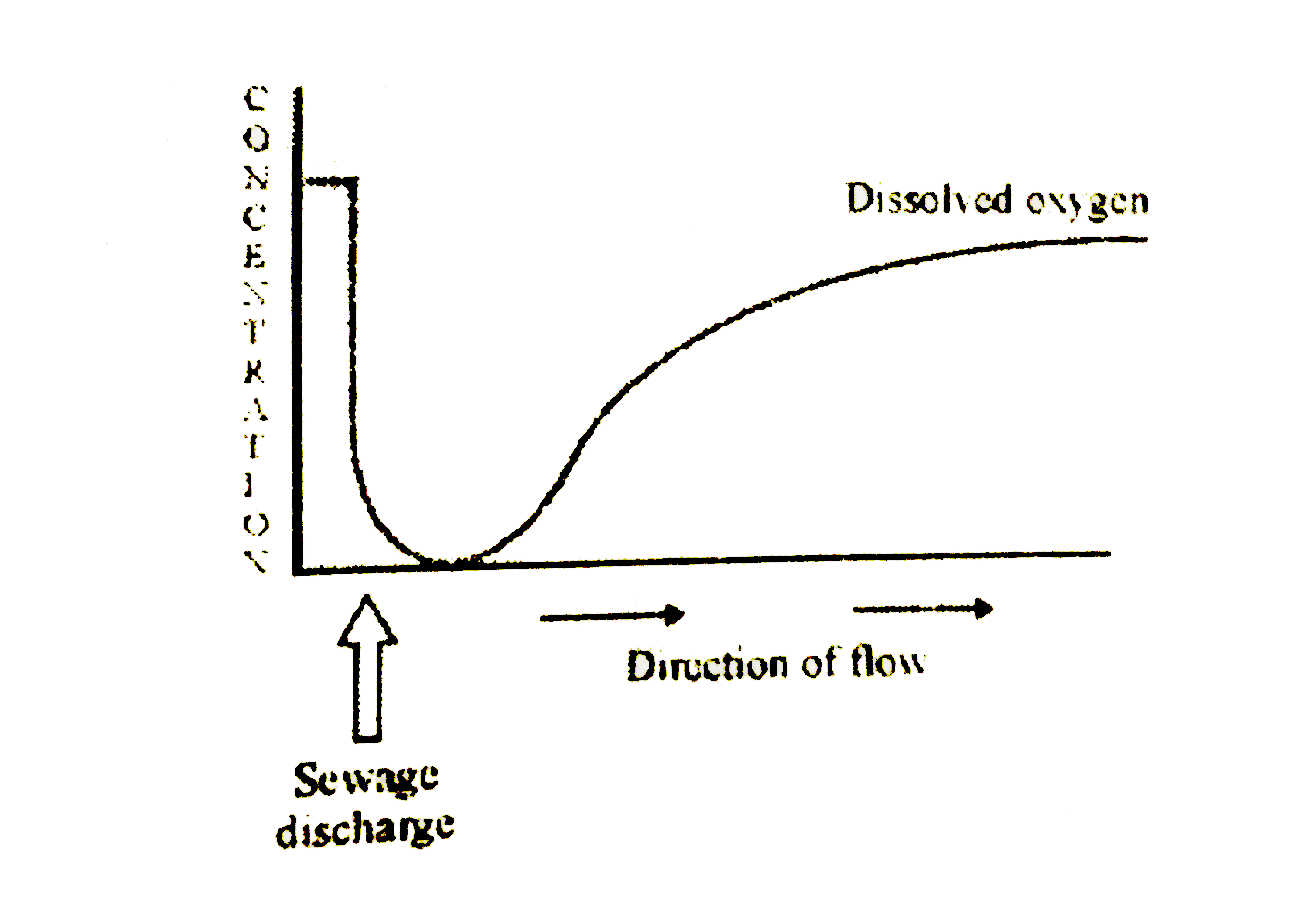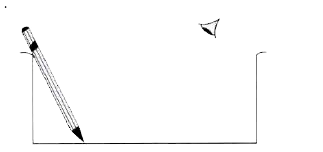Explain the change that can be observed in the characterstics of river water when sewage is discharged into it and a few weeks after the discharge with respect to
(i) level of dissolved oxygen
(ii) Population of fresh water organisms.
To explain the changes observed in the characteristics of river water when sewage is discharged into it and a few weeks after the discharge, we can break down the analysis into two main aspects: (i) the level of dissolved oxygen and (ii) the population of freshwater organisms.
1. Initial Sewage Discharge:
- When sewage is first discharged into the river, the concentration of organic matter in the water increases significantly. This is due to the introduction of nutrients and organic waste from the sewage.
2. Change in Dissolved Oxygen Levels:
- Immediately After Discharge: The level of dissolved oxygen (DO) in the river water decreases sharply. This is because the organic matter present in the sewage begins to decompose, a process that requires oxygen. As bacteria and microorganisms break down the organic matter, they consume the available dissolved oxygen, leading to a drop in its concentration.
- A Few Weeks After Discharge: Over time, as the organic matter is decomposed, the concentration of organic waste decreases. Consequently, the demand for oxygen also decreases, allowing the levels of dissolved oxygen to gradually rise again. Eventually, the river may return to a more balanced state, but this can take time depending on the extent of pollution.
3. Change in Population of Freshwater Organisms:
- Immediately After Discharge: The initial increase in organic matter and the subsequent decrease in dissolved oxygen creates an unfavorable environment for many freshwater organisms. Species that rely on higher levels of oxygen, such as fish and certain invertebrates, may begin to die off due to hypoxia (low oxygen conditions).
- A Few Weeks After Discharge: As the organic matter is decomposed and the oxygen levels begin to recover, some freshwater organisms may start to re-colonize the area. However, the initial die-off may have led to a significant reduction in biodiversity, and it may take time for the ecosystem to stabilize and recover fully.
Summary:
- Dissolved Oxygen: Initially decreases due to increased organic matter and decomposition, then gradually increases as organic matter is broken down.
- Population of Freshwater Organisms: Initially decreases due to lack of oxygen, with potential recovery as conditions improve, but biodiversity may be affected.
- When sewage is first discharged into the river, the concentration of organic matter in the water increases significantly. This is due to the introduction of nutrients and organic waste from the sewage.
- Immediately After Discharge: The level of dissolved oxygen (DO) in the river water decreases sharply. This is because the organic matter present in the sewage begins to decompose, a process that requires oxygen. As bacteria and microorganisms break down the organic matter, they consume the available dissolved oxygen, leading to a drop in its concentration.
- A Few Weeks After Discharge: Over time, as the organic matter is decomposed, the concentration of organic waste decreases. Consequently, the demand for oxygen also decreases, allowing the levels of dissolved oxygen to gradually rise again. Eventually, the river may return to a more balanced state, but this can take time depending on the extent of pollution.
- Immediately After Discharge: The initial increase in organic matter and the subsequent decrease in dissolved oxygen creates an unfavorable environment for many freshwater organisms. Species that rely on higher levels of oxygen, such as fish and certain invertebrates, may begin to die off due to hypoxia (low oxygen conditions).
- A Few Weeks After Discharge: As the organic matter is decomposed and the oxygen levels begin to recover, some freshwater organisms may start to re-colonize the area. However, the initial die-off may have led to a significant reduction in biodiversity, and it may take time for the ecosystem to stabilize and recover fully.
- Dissolved Oxygen: Initially decreases due to increased organic matter and decomposition, then gradually increases as organic matter is broken down.
- Population of Freshwater Organisms: Initially decreases due to lack of oxygen, with potential recovery as conditions improve, but biodiversity may be affected.
Topper's Solved these Questions
Similar Questions
Study the graph given below. Explain how is oxygen concentration affected in the river when sewage is discharged into it.

View SolutionExplain the process of sewage water treatment before it can be discharged into natural water bodies . Why is this treatment essential ?
View SolutionExplain the process of sewage water treacment before it can be discharged into natural water bodies . Why is this treatment essential ?
View SolutionA student puts his pencil into an empty trough and observes the pencil from the position as indicated in Figure.

(i) What change will be observed in the appearance of the pencil when water is poured into the trough?
(ii) Name the phenomenon which accounts for the above stated observation.
(iii) Complete the diagram showing how the student's eye sees the pencil through water.
View SolutionWhen domestic sewage mixes with river water
(a) small animals like rats will die after drinking river water
(b) the increased microbial activity releases micronutrients such as iron
(c) the increased microbial activity uses up dissolved oxygen
(d) the river water is still suitable for drinking as impurities are only about 0.1 %
View SolutionExplain the following with proper reason:
(i) Bleaching of flowers by chlorine is permanent while after bleaching with SO2, the colour returns.
(ii) Iodine dissolves more in KI solution than in water.
View Solution(a) A student dropped a few pieces of marble in dilute hydrochloric acid contained in
a test tube. The evolved gas was passed through lime water. What change would
be observed in lime water ? Write balanced chemical equations for both the
changes observed.
(b) State the chemical property in each case on which the following uses of baking
soda are based:
(i) as an antacid (ii) as a constituent of baking powder.
View SolutionWhen a boat travels in a river (strictly in a straight line), it can go either in the direction of flow of river (i.e downstream) or in the direction opposite the flow of river (i.e. upstrem ). Thus the boat's actual speed is more than by which it can move in stationary water while travelling downstram (as river's flow speed is added to it) and less while travelling upstream (as the boat moves against the flow of river).Based on the given information answer the following questions A boat going downstream in a following river overcome a raft at a point P. 1 h later it turned back and after some time passed the raft at a distance 6 km from point P.
Find the speed of river
View SolutionWhen a boat travels in a river (strictly in a straight line), it can go either in the direction of flow of river (i.e downstream) or in the direction opposite the flow of river (i.e. upstrem ). Thus the boat's actual speed is more than by which it can move in stationary water while travelling downstram (as river's flow speed is added to it) and less while travelling upstream (as the boat moves against the flow of river).Based on the given information answer the following questions A boat going downstream in a following river overcome a raft at a point P. 1 h later it turned back and after some time passed the raft at a distance 6 km from point P.
After reversing its direction ,how much time was taken by the boat to meet the raft again ( i.e. 2nd time) ?
View SolutionA car has a fresh storage battery of emt 12V and internal resistance 5.0×10−2Ω. If the starter moter draws a current of 90A, what is the terminal voltage of the battery when the starter is on?
(b) After long use, the internal resistance of the storange battery increase to 500Ω. What maximum current can be drawn from the battery? Assume the emt of the battery to remain unchanged.
(c) If the discharged battery is changed by an external emf source, is the terminal voltage of the battery during changing greater of less than is emf 12V?
View Solution
